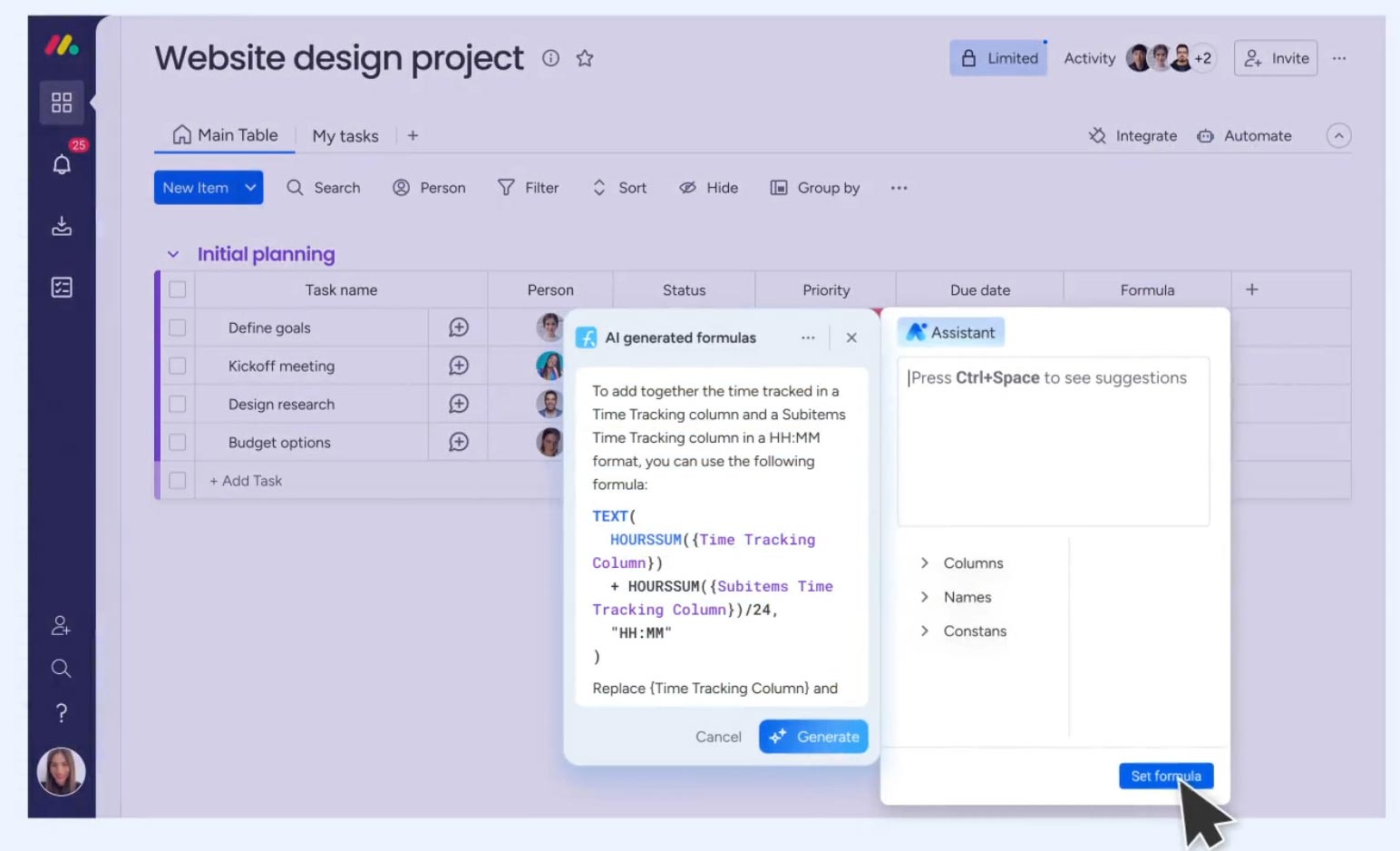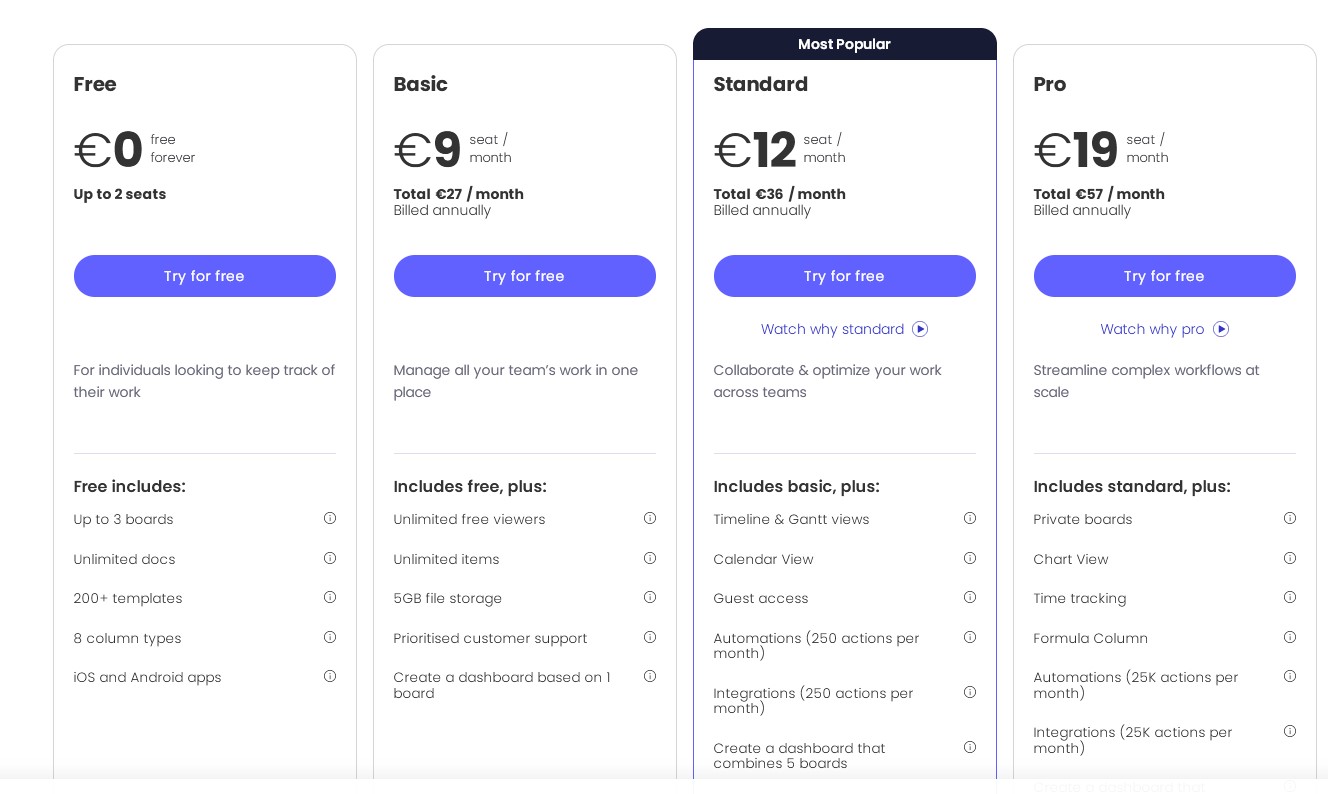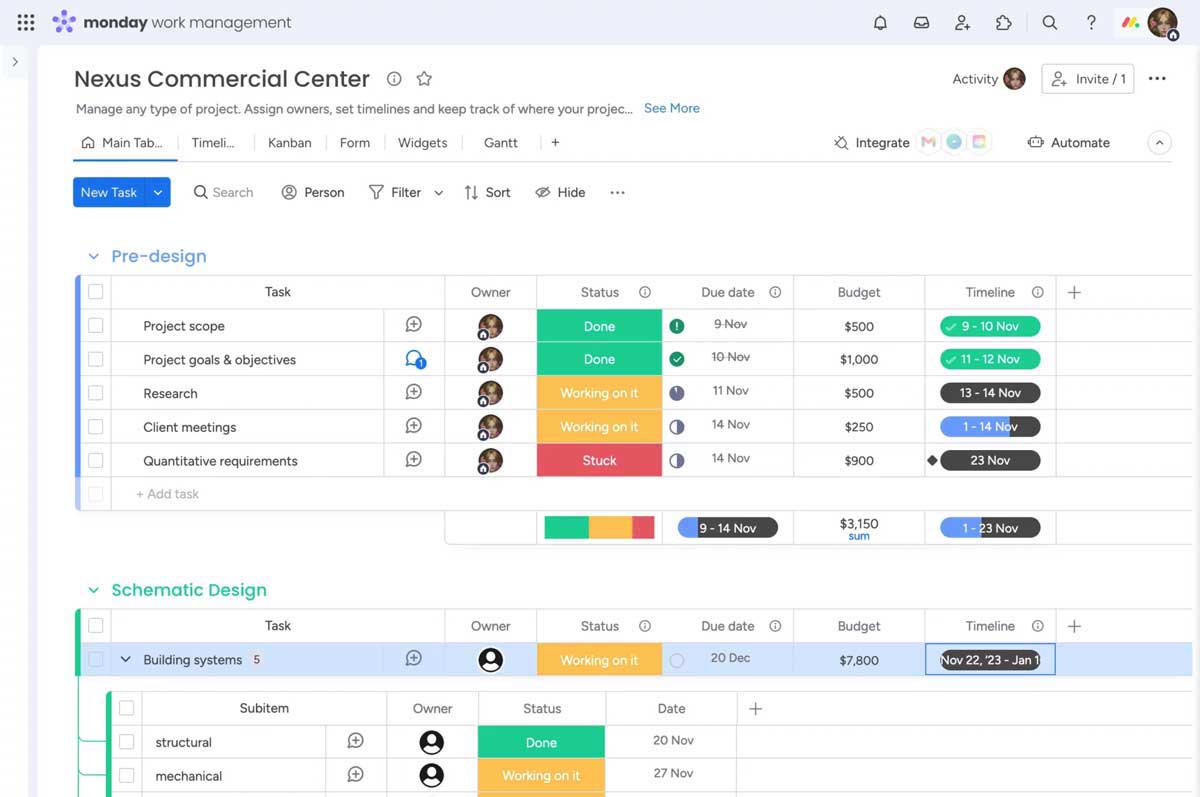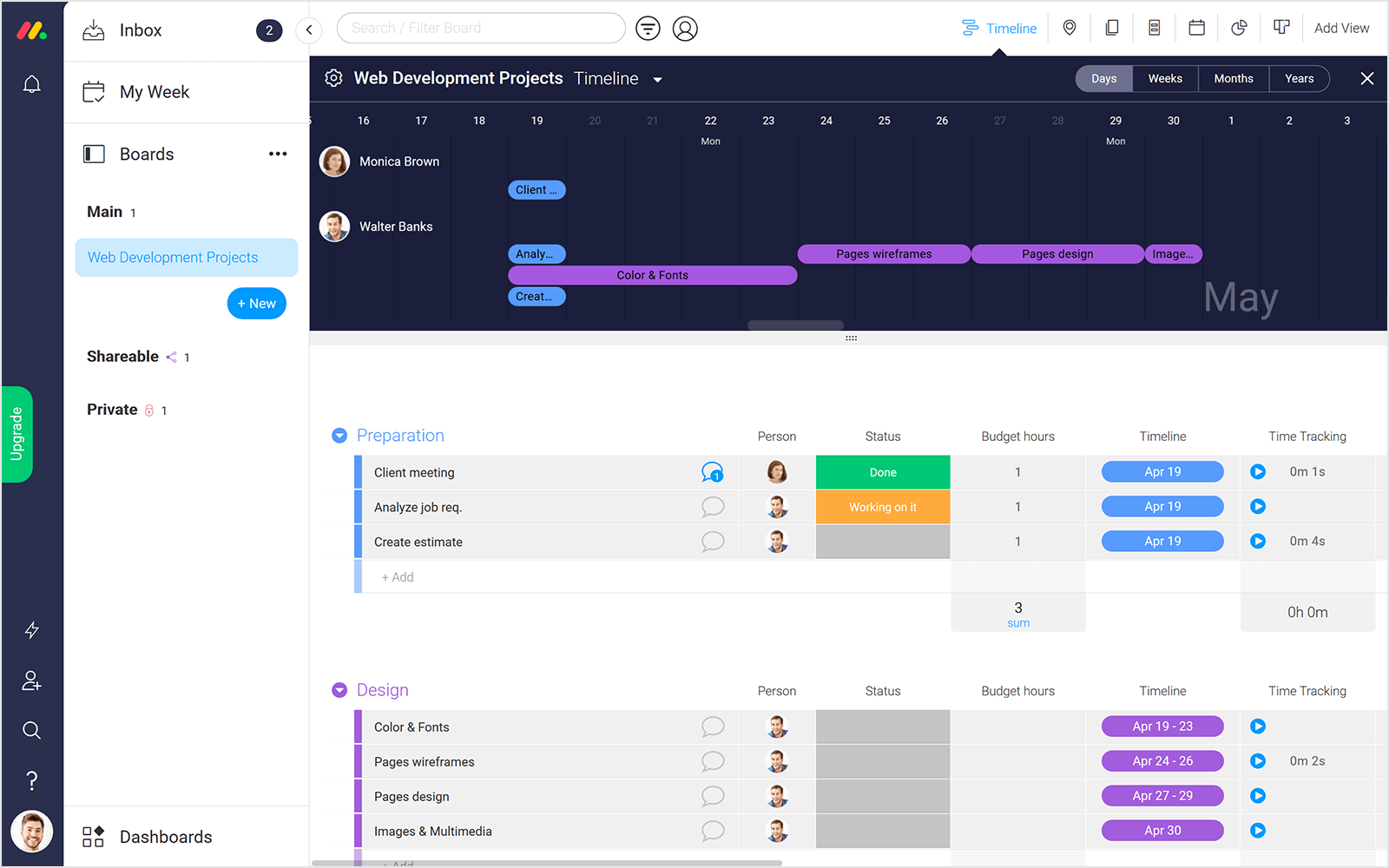
Monday Review: Pros & Cons
Pros & Cons of Monday
Pros
Aesthetically pleasing UI
Many customization options
Workflow automation features
Above average on intuitiveness
Cons
High price
Live chat is not reliable
Mobile app is slow and clunky
Confusing notification system
Monday's Standout Features
Monday.com stands out with a colorful interface and clean design, making navigation a breeze. This visually appealing style, dubbed "intuitive" by many users, aims to create a fun and engaging project management experience. Some users may find this aesthetic more intuitive compared to traditional hierarchical structures employed by other platforms. However, keep in mind that intuitiveness can be subjective, and what works for one might not click for another. The platform's unique flat task structure, described as "an intuitive way to organize information," offers a straightforward approach compared to traditional hierarchical systems in other project management tools, making it more accessible for various teams and project types.

While some users praise the flat structure for its clarity, others might find it less suitable for complex projects requiring intricate organization. It's worth noting that this approach differs significantly from the hierarchical systems employed by tools like Asana or Trello and might take some adaptation for users accustomed to those platforms.
Another thing most users agree on is that Monday.com offers exceptional customization. Unlike its peers, you can truly mold the platform to your specific needs. Think of it as creating a personalized dashboard – add relevant columns like "Status" or "Assigned To," and choose how you view tasks (list or calendar). Only a few competitors match Monday.com's level of customization, such as ClickUp, Scoro, and Podio. However, many of these alternatives fail to provide an interface that's as visually appealing and colorful as Monday.com's.

Workflow automation is a notable feature in Monday, excelling in automating routine tasks, sending reminders, and initiating basic workflows through triggers and actions like notifications, task assignments, or field updates. While it's well-suited for straightforward automations, those requiring complex, multi-step processes or deeper integrations might find more advanced capabilities in other platforms.

Monday.com's vibrant colors and flat structure hold immense appeal for many. This Kanban-esque layout, like a colorful playground buzzing with tasks, feels refreshingly simple compared to traditional hierarchical systems. Users laud its visual clarity and drag-and-drop functionality, praising its ease of learning and navigation. However, this very flexibility can be a double-edged sword; some users find the abundance of features overwhelming, requiring more effort to master compared to Asana's streamlined interface.
Monday.com is exploring AI integration, focusing initially on content assistance and text optimization to enhance project management. While these features facilitate email drafting and text refinement, their impact on project management processes is currently limited. From my perspective this is just an attempt to capitalize on the AI trend without delivering substantial project management improvements. For those seeking advanced AI in project management, platforms like Replicon, RescueTime, and Timely offer AI-driven solutions for streamlining tasks like timesheet creation, though the effectiveness of these solutions will certainly vary a lot.

Who Benefits Most from Monday
- The Visual Thinkers: Imagine a team of designers, marketers, or product developers. Their world revolves around visuals, and Monday.com speaks their language. With its colorful boards, drag-and-drop functionality, and Kanban-style layout, tasks transform into engaging cards, visually representing progress and sparking creative flow. This visual representation of information promotes clear communication and easy-to-grasp overviews, ideal for teams who thrive on seeing the bigger picture at a glance.
- Agile Adopters: Embracing continuous improvement? Monday.com's Kanban boards and sprint management features align perfectly with Agile methodologies. Track progress visually, iterate quickly, and celebrate wins as a team - all within the platform's dynamic interface.
- Hyper-Specific Specialists: Whether you're a team of forensic accountants tracking complex financial transactions or a group of astrophysicists analyzing data sets, Monday.com's customizable columns and data types cater to your unique information needs. Create columns for specific metrics, calculations, or even file types like lab reports or MRI scans, ensuring your data stays organized and relevant to your specialized field.
What Users Love About Monday
Users who frequently use Monday on a daily basis particularly enjoy these three things:
- Visually appealing interface: Many users find the clean design, bright colors, and flat task structure easy to understand and navigate, making it more enjoyable to use than traditional hierarchical systems.
- High degree of customization: Users appreciate the ability to tailor the platform to their specific needs by adding custom columns, changing views, and setting up automations. This flexibility allows them to organize information in a way that works best for them.
- Variety of features: Users enjoy the wide range of features offered by Monday.com, including automations, integrations, and mobile app functionality.
Top Complaints About Monday
While Monday.com wins hearts with its visually appealing interface, some concerns cloud the user experience. Let's dive into the not-so-sunny side of the platform:
The biggest thorn in many users' sides is the pricing structure. As your team grows and needs more features, the cost can escalate quickly, making it a less attractive option for budget-conscious individuals or small businesses. Remember, that cute interface might come with a hefty price tag later on.
Complaints about the live chat team being inefficient, unresponsive, and even dismissive are quite common. Imagine needing help and getting tossed between departments or waiting endlessly for a response – not exactly the supportive team you expected.
Here are some specific quotes:
Every single time I try to speak to their live chat, I get passed between 3 separate teams before they tell me they cannot help and need to transfer the question to an email ticket.
I whole-heartedly feel like they do not care about timely responses, nor do they seem to care about follow-ups or responding to emails in general.
Live chat support is awful.
The feedback reveals a notable dissatisfaction with Monday.com's customer support regarding quality and response times, contrasting sharply with the positive experiences reported by the support teams of competitors like Paymo and ClickUp.
Automations are a defining feature that differentiates this app from many project management tools, offering functionalities akin to those found in ClickUp. Yet, feedback indicates some users encounter limitations and bugs within these automation features. If leveraging automations is crucial for your workflow, it's wise to initially commit to the shortest possible subscription to thoroughly test their effectiveness and ensure they meet your needs before considering a longer-term commitment.
The mobile app provides basic functionality and some convenience but doesn't match the web version's user experience. It's seen as lacking in features, particularly for task creation and automation, and is described as slow, affecting usability. Notification issues further impact the effectiveness of on-the-go monitoring. Despite the web interface's positive reception, the mobile app's user experience is considered less intuitive.
Monday vs. The Competition
Monday's closest competitors in feature depth and customization are ClickUp, Scoro, and Podio, known for their extensive functionalities and customization. Scoro excels in client management, while ClickUp is unparalleled in customization. Asana, often compared to Monday, shines with its intuitive interface. For those valuing communication, Basecamp and Redbooth focus on these features but lack Monday's advanced automation and customization.
Monday.com provides two time-tracking methods within tasks: a manual timer and post-task manual entry. Integrating tools like Harvest or Everhour might be needed for comprehensive time analysis and billing. However you need detailed reports on project time, team performance, or client billing, and you don’t want to deal with integrations, then dedicated solutions like Paymo or TrackingTime could be more suitable.
If simplicity and a straightforward interface are your priorities, with no interest in extensive customizations like setting up columns or dashboards, ActiveCollab might be a more suitable choice. It offers a considerable feature set but with limited customizability, which may not be ideal for managing larger or more complex projects.
For rigorous employee oversight, Hubstaff provides features such as screenshots, URLs, and keyboard and mouse activity monitoring for employees oversight. Although I am strongly against them for privacy concerns, there might be scenarios where this level of monitoring is deemed necessary.
Price and Cost Comparison

The key aspect of Monday.com's pricing that users often point out is the substantial increase in costs as more users and features are added. This can make the platform significantly more expensive for larger teams or those needing advanced functionalities. Monday’s pricing model may pose challenges for small businesses or individuals with limited financial resources, leading some to feel excluded or compelled to settle for plans that fall short of their requirements.
Monday.com's basic plan, priced at $9, contrasts with ClickUp's more affordable $7 option, which notably includes unlimited integrations. Additionally, while Monday.com's $12 Standard plan does introduce integrations, it constrains users with a monthly action limit of just 250, which is a significant limitation.
Monday.com's limited time tracking features are not included in its Basic or Standard packages, requiring an upgrade to the Pro package, which starts at $19 per user per month. In contrast, Paymo, a tool specializing in time tracking, offers automated features in its most affordable package at $5.9.
Monday.com's Basic plan lacks crucial features like a private messaging system and advanced search, presenting significant limitations compared to industry standards. Additionally, it's not the most affordable option available.
Many users find Monday.com's pricing structure challenging, especially when scaling up the number of team members, leading to higher costs. This can be particularly burdensome for small businesses or individuals, making the platform less accessible for those with strict budget constraints. If the difference in annual cost, such as $500 versus $1500, is significant for you, exploring alternatives might be beneficial. Here are a few alternatives to consider:
Freedcamp and Paymo are cost-effective alternatives to Monday, catering to users who value cost savings over a broad feature set and extensive customization capabilities. ClickUp also presents a more budget-friendly choice without compromising on customization features. Freedcamp is particularly recognized for its robust free tier and competitively priced premium plans, positioning it as an attractive option for those seeking to efficiently manage tasks and projects on a tight budget, with pricing beginning at $1.49 per user per month when billed annually. Starting at $5.9, Paymo appeals to small businesses with its advanced time tracking and invoicing features, offering unlimited capabilities in these areas, albeit with less customization and fewer integrations than Monday. For those who prioritize customization without wanting to overspend, Clickup emerges as a viable, more economical alternative.
For teams with particular headcounts, like 8 or 16 members, Flowlu offers an appealing pricing strategy that becomes more cost-effective for groups of 8 users. This tailored approach makes it an ideal choice for those looking for a budget-friendly pricing model while still accessing a full suite of features.
Monday’s Privacy & Security
Monday.com's security and privacy framework aligns well with industry standards, providing a secure environment that's crucial for end users. The platform's use of advanced encryption for both data at rest and in transit (using AES-256 and TLS 1.3, respectively) matches the security measures implemented by leading cloud services. This ensures that user data is protected through the latest, most robust encryption standards.
Authentication methods, including two-factor authentication and support for single sign-on options, are on par with what's expected from top-tier SaaS platforms, offering users both security and convenience. The option for administrators to enforce strong password policies further strengthens individual account security.
The geographical distribution of data centers, including options in the EU for enterprise customers, addresses data sovereignty concerns and provides redundancy, which is vital for data protection and service availability. This approach is consistent with best practices in cloud infrastructure management.
Monday.com's adherence to stringent compliance standards, such as ISO certifications and GDPR compliance, highlights its commitment to not just meeting but exceeding global data protection requirements. This comprehensive compliance framework is indicative of a mature security posture.
Lastly, the presence of a dedicated security team led by a CISO underscores Monday.com's ongoing commitment to security and privacy, ensuring that these considerations remain at the forefront of their operational priorities.
In comparison with industry norms, Monday.com offers a solid security and privacy package that should meet the expectations of most end users, especially those from organizations that prioritize data protection in their cloud-based solutions.
Monday's Update Frequency
While Monday.com doesn't show a clear roadmap of future features, they actively update their "What's New" page to inform users about the latest enhancements and additions to their platform. This page showcases the latest updates, including new features like WorkCanvas, a collaborative digital whiteboard, enhanced board communication via Board Discussions, advanced project management tools through improved dependencies, view locking to prevent edits, a revamped Date Column for better data input, and the addition of Emoji reactions for updates.
While Monday.com demonstrates continuous growth and updates, it does not match the pace and scale of updates seen in Clickup, which is recognized for its aggressive feature rollout and innovation. For those valuing the frequency and impact of new features in their long-term planning, comparing Monday.com's update strategy to Clickup's could be crucial.
Monday Company History
Monday.com wasn't always the vibrant, feature-rich project management platform we know today. Its journey began in 2012, a mere seed planted by Roy Mann and Eran Zinman - a duo who experienced firsthand the challenges of scaling organizations. Their vision? A tool that was not just functional but delightful to use. Christened "dapulse" in its early days, the platform focused on basic task management and communication. By 2014, it had blossomed into Monday.com, attracting seed funding and garnering early adopters with its intuitive interface and collaborative features.
The following years witnessed a period of rapid growth. Monday.com secured further investments, expanded its functionalities, and embraced a vibrant design aesthetic. Kanban boards and customizable columns made their debut, allowing users to tailor the platform to their unique workflows. This emphasis on personalization became a cornerstone of Monday.com's identity. As the platform matured, so did its ambitions. Integrations with popular tools like Google Drive and Slack streamlined workflows, while automations added a layer of intelligence, reducing manual tasks and boosting efficiency.
However, the journey isn't over. Monday.com continues to evolve, embracing new technologies and trends. Artificial intelligence integration, for instance, promises to automate tasks further and provide data-driven insights.
The Final Verdict on Monday
Monday.com's vibrant interface and unparalleled customization have won over many hearts. Its Kanban-style layout and drag-and-drop functionality offer an intuitive and engaging project management experience, especially for visually-oriented teams. However, the platform isn't without its downsides. The cost can escalate quickly, particularly for larger teams or those needing advanced features. Additionally, concerns regarding customer support and mobile app limitations require consideration.
However, if budget constraints are tight or advanced features like time tracking and extensive automation are crucial, exploring alternatives like ClickUp, Paymo, or Freedcamp might be beneficial. Ultimately, the decision depends on your specific needs and priorities.
Written by Remus Zoica






